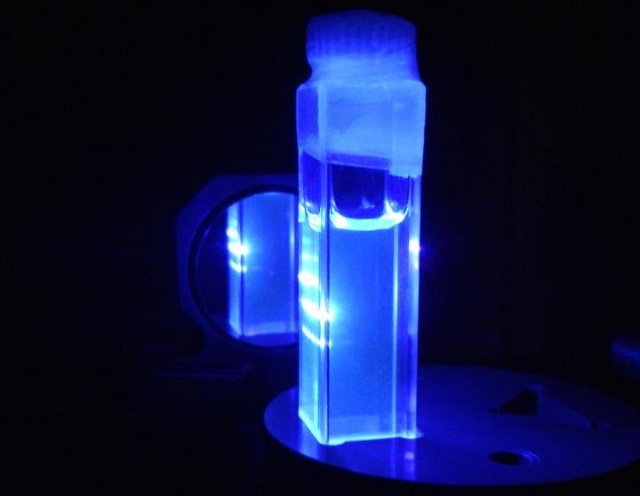
This is an image of a laser solution. (Image credit: CSIC AND AV ?R)
Spanish National Research Council (CSIC) researchers Inmaculada García-Moreno and Luis Cerdán along with Michael Londesborough, borane specialist from the Institute of Inorganic Chemistry have developed a method to emit laser light from boron hydrides, or boranes. Their findings have been published in Nature Communications.
The researchers have revealed that boranes are capable of degradation-resistant and efficient laser emission in the blue spectral region, suited for applications such as materials processing or spectroscopy. Their research work could aid in decreasing not just the cost but also the environmental effect of liquid lasers.
Although lasers were first created in 1960, 55 years later researchers continue looking search for new materials that are capable of emitting tuneable, efficient and stable blue laser light, and are profitable as well as easy to produce and process.
Nowadays there exists a diverse range of commercial materials that are close to fulfilling those requirements, but they present some practical inconveniences. In our study we present a solution that seeks to contribute to overcome these limitations.
Inmaculada García-Moreno
CSIC Researcher at the Institute of Physical Chemistry, Rocasolano
Compared to other laser materials used thus far, boranes possess unique a structure and properties which are very similar to organic dyes, therefore helping it to emit laser light in a tuneable and efficient manner. This implies that boranes can produce laser light with very high energy and controllable color.
Organic dyes however degrade easily, therefore requiring regular renewal of the laser material. The borane laser material however displays resistance to degradation that is greater or comparable to some of the commercially accessible advanced blue laser dyes.
We have concentrated our work on solutions of anti-B18H22, a cluster-like molecule with architecture resembling that of a split soccer ball.
We are highly excited by this discovery. The boranes, with their unique molecular structures and high photostabilities, present a new and previously untapped resource for laser technology.
Michael Londesbrough
Borane Specialist at the Institute for Organic Chemistry
One of the advantages of possessing high resistance to degradation is that the amount of times the liquid medium needs to be replenished is minimised, thereby aiding in resolving occupational hazards, cost, and environmental issues due to the use of toxic and flammable solvents.
The researchers are now aiming to synthesize the borane laser material in a way that can emit at other wavelengths to expand its applications to other fields such as dermatology for tattoo, scar or acne removal, as well as for use in treatments of vascular lesions.
"There is still plenty of work to be carried out before these compounds can reach the commercial shelves, but the scientific relevance of this discovery represents a milestone in the history of lasers, since there are not many occasions in which a new family of laser materials is unveiled," concludes Luis Cerdán, a CSIC researcher at the Institute of Physical Chemistry Rocasolano.